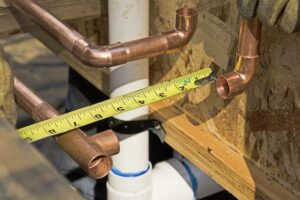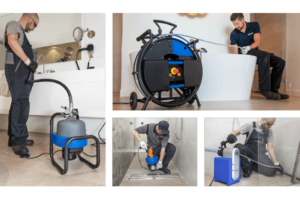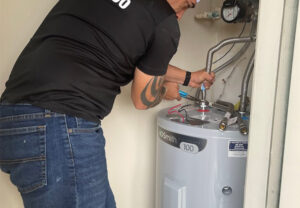Residential Doylestown PA Plumbers work on plumbing mechanisms found in homes. These include water pipes, bathroom fixtures and waste removal systems. They also troubleshoot plumbing problems like leaks and clogs.

Plumbers usually start their careers by completing an apprenticeship program. This mixes paid on-the-job training with classroom instruction. They must also pass certification exams.
Plumbing is a vital service that must be kept working properly to ensure the flow of water. It can be challenging for homeowners to identify problems with their plumbing, but professional plumbers have the training and experience necessary to make quick fixes and install new pipes if needed. Residential plumbers can offer a variety of services, including drain cleaning and leak detection, to keep your plumbing system running smoothly.
The main difference between a commercial and residential plumber is that commercial plumbers work with larger systems, such as those found in schools and shopping centers. They also tend to work with pipes that connect to large industrial equipment. Commercial plumbers need a lot of education and training to be able to repair and maintain these large pipe systems.
In contrast, residential plumbers primarily work with smaller systems in homes and apartment buildings. These plumbers are usually more familiar with the plumbing fixtures and layouts that are typical of a home. Because of this, they can often diagnose and repair issues more quickly and efficiently than a commercial plumber would.
Leaks, clogs and broken water heaters are common household problems that can be caused by poor installation or aging plumbing parts. Residential plumbers can repair or replace these fixtures and help their customers understand how to avoid future issues. They can also install new plumbing in homes that are being built or renovated.
In some cases, a residential plumber may need to work on natural gas lines as well. This is a risky task that requires special training and a separate license. A plumber with this training can work on sewer lines, water heaters and even heat pumps in a home.
To become a licensed plumber, applicants must complete an apprenticeship and pass a state exam. In addition, they must have at least seven years of experience working on plumbing construction, maintenance and repair in a commercial or residential building. They must also have two years of experience working in the design or installation of plumbing systems under a licensed master plumber supervisor.
Repair
Residential plumbers repair plumbing systems in single-family homes. They can fix issues like clogged toilets and drains, replace water heaters, install new faucets or shower heads, and perform whole-house re-piping. They also make sure that all plumbing fixtures meet local plumbing codes and regulations. Many plumbers complete an apprenticeship as part of their training, working under a journeyman plumber to learn the trade and gain experience.
When it comes to repairing plumbing systems, residential plumbers can work on pipes made from PVC, ABS, copper, or galvanized steel. Pipe materials vary from house to house, and plumbers may choose different types of replacement parts depending on the availability and cost of those parts in the area. For example, if an older home has galvanized pipes, the plumber might replace them with PVC or ABS to avoid future problems with rusting and corrosion.
In addition to repairing and replacing pipes, residential plumbers can also handle sewer backups. These are a serious concern for any homeowner, and can occur when something clogs the lines that carry waste from the house to the sewer system. If the problem is not addressed quickly, it can cause sewage to back up into the house, which is a health hazard and requires immediate attention from a licensed plumber.
Plumbers can help homeowners with regular maintenance services, such as yearly inspections of the plumbing systems to identify and address any potential problems before they become major issues. These services are typically included in a plumber’s contract with the homeowner, and can help homeowners save money on monthly utility bills.
Commercial plumbing is a complex field that involves the installation and maintenance of large water supply systems and sewage removal systems for restaurants, hotels, malls, and office buildings. These systems must comply with strict building codes and can be complicated to work on. Commercial plumbers are trained to understand and work with a variety of building structures and plumbing systems.
Unlike residential plumbing, which deals with the plumbing systems in individual homes, commercial plumbing concerns larger buildings, such as offices, restaurants, and apartment complexes. These buildings often have multiple bathrooms, kitchens, and laundry rooms, each with its own unique set of plumbing needs. Commercial plumbing is a challenging field that requires specialized training to master.
Maintenance
While a residential plumber focuses on plumbing installation and repairs within a client’s home, they also perform preventative maintenance. They can install backflow devices to protect water quality and help prevent contamination, which is especially important in a house with multiple toilets or kitchen appliances. They can also thaw frozen pipes and help with drain cleaning. They are also knowledgeable about how to keep a home’s plumbing running smoothly and efficiently, such as by replacing worn-out washers and valves.
Residential plumbers typically work on a variety of plumbing projects, including toilet repairs and replacements, garbage disposal installation, whole house re-pipes, and shower and bathtub installations. They are familiar with a wide range of plumbing materials and fixtures, including copper, PVC, and ABS. They can also install gas and sewer lines, including trenchless technologies. Additionally, they can repair or replace sump pumps and backflow prevention devices.
Plumbing systems in commercial buildings are generally more complex than those in homes, and they require more regular maintenance. Plumbers who service large buildings know how to work with a variety of pipe sizes and types, and they are often required to use more industrial-grade fixtures. Moreover, since a commercial building has many more sinks and toilets than a single-family home, the plumbing system is more likely to experience leaks and other problems.
In addition to repairing plumbing, a commercial plumber can also assist with the design and construction of new buildings. They are often required to create a blueprint of the plumbing system before beginning any construction, and they may be responsible for inspecting the finished project to ensure it meets local building codes. They can also help with the design of new spaces, such as by ensuring that the layout of electrical wiring is appropriate for the building’s intended uses.
A commercial plumber can also help with the installation of backflow devices, which are used to protect against the contamination of drinking water. These are often required in places like greenhouses, medical and dental offices, and residential properties with multiple water heaters or septic systems. They are also experienced in snaking drain lines and can clean out sewers using a variety of tools, including power snakes.
Troubleshooting
Residential plumbers troubleshoot and repair a wide range of plumbing issues, from leaking pipes to clogged drains. They can also install water heaters, fix toilets and bathtubs, and make sure that all components of the plumbing system are working properly. They may also test a home’s water quality and ensure that there are no leaks or dangerous chemical build-ups.
Because residential plumbing systems are typically smaller than those in commercial buildings, they tend to be less prone to problems. However, this doesn’t mean that they are immune to damage or wear and tear. Like any other part of a building, plumbing can wear out over time due to age, use or improper installation. To avoid expensive repairs and replacements, it’s important to maintain your plumbing system regularly. This includes performing regular inspections by a licensed plumber, fixing any issues as soon as possible, and using high-quality parts.
Plumbing maintenance often involves repairing or replacing worn out parts. Residential plumbers can replace corroded valves, fix broken faucets or shower heads, and ensure that all parts of the plumbing system are functioning correctly. They can also recommend new fixtures if the homeowner is looking to upgrade their home’s appearance or functionality.
Another common service that residential plumbers offer is detecting and fixing underground sewer line problems. These problems can cause serious flooding and health issues if not addressed quickly. To prevent them, a plumber can install backflow prevention devices in toilets and drains, repair or replace damaged sections of pipe, and use air compressors to clear blockages.
Sewer backups are a common problem that can affect entire households. They can be caused by tree roots, broken pipes, grease clogs, or poor drain design. To deal with a sewer backup, a plumber can use augers, drain snakes, or chemical solutions to break up and remove the clog. They can also install cleanouts to help with drainage and prevent future clogs.
While some homeowners choose to do DIY plumbing repairs, it is always best to hire a professional. This will ensure that the job is done correctly and safely, preventing any damage to the pipes or fixtures. A reputable plumbing service will also provide annual inspections for their clients, which can detect any potential issues before they become major problems.

